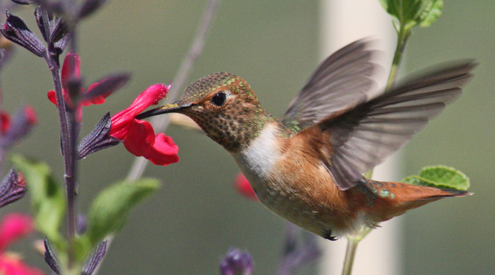
By Jessica Ordóñez-Lancet – May 05, 2020
RESTON, Va. — Even in these uncertain times, the National Wildlife Federation’s 8th Annual Garden for Wildlife Month offers Americans a way to safely and responsibly connect with nature. From home gardeners to wildlife enthusiasts and conservationists, the Garden for Wildlife program offers everyone an accessible way to help their local wildlife. New research commissioned by the National Wildlife Federation shows Americans are changing the way they garden to benefit wildlife and the planet.
“The new National Gardening Survey shows people across America are purposefully planting for wildlife, making a conservation difference where they live and advancing the wildlife gardening movement,” said Mary Phillips, senior director of Garden for Wildlife. “At the National Wildlife Federation, we hope even more people will find solace in wildlife gardening and plant with purpose, creating eco-friendly green space to relax, rejuvenate and get some much-needed outdoor time during these unprecedented times. While millions invite butterflies, birds and bees to their yards by replacing lawn with native plants, smaller habitat oases can also be created in backyards, porches, patios or even windowsills.”
Preliminary research from the 2020 National Gardening Survey, conducted by the National Garden Association and the University of New Hampshire Survey Center on behalf of the National Wildlife Federation, showed:
- Over the last three years, 64.1 million or one in four American adults purchased a plant because it was beneficial to birds, bees or butterflies. People who identified as Latino or Hispanic represented the highest numbers purchasing wildlife beneficial plants.
- 36.8 million (one in seven) or 14 percent of American adults purchased plants native to where they live in 2019.
- 23.1 million or 9 percent of American adults converted part of their lawn to natural/wildflower landscape in 2019.
- 18-34-year-olds, self-identifying as African American, Black or Caribbean, are more likely to spend more on organic lawn and gardening products and materials than other groups.
This spring, the National Wildlife Federation’s Garden for Wildlife program has seen its highest demand in its 47-year history, with six times the number of usual website visitors and annual Certified Wildlife Habitat® registrations doubling in the first quarter, contributing to the 242,000 total habitats registered to date. People are drawn by beautiful results as science confirms they are making a difference to increase abundance and diversity of wildlife species.
This year, the National Wildlife Federation is also providing Americans with creative and new resources to use at home, including a downloadable Recipe Guide for creating herb-based beverages with their wildlife garden crops, which can be obtained by signing up for the program’s newsletter. Spanish language materials and tools are now also available through our newly published Jardín Silvestre site.
With increasing demand for online resources, Garden for Wildlife has also partnered with Botanical Interests to provide organic, non-GMO treated, open pollinated seed directly to homes. Gardener’s Supply, another new partner, ships organic soil and sustainable tools and garden materials.
Garden for Wildlife’s signature program, Certified Wildlife Habitats® is closing in on its goal to reach 250,000 sites by 2021, encompassing backyards, gardens and community spaces. These areas support and protect the future of birds, bees, butterflies and other amazing wildlife. No matter their age or location, anyone can participate with almost immediate results — potentially doubling the numbers of diverse local wildlife. The National Wildlife Federation has also partnered with Taylor Morrison, the country’s fifth-largest homebuilding company with 430 communities in 11 states, to certify more than 8,000 acres of open space as wildlife habitat in its developments.
